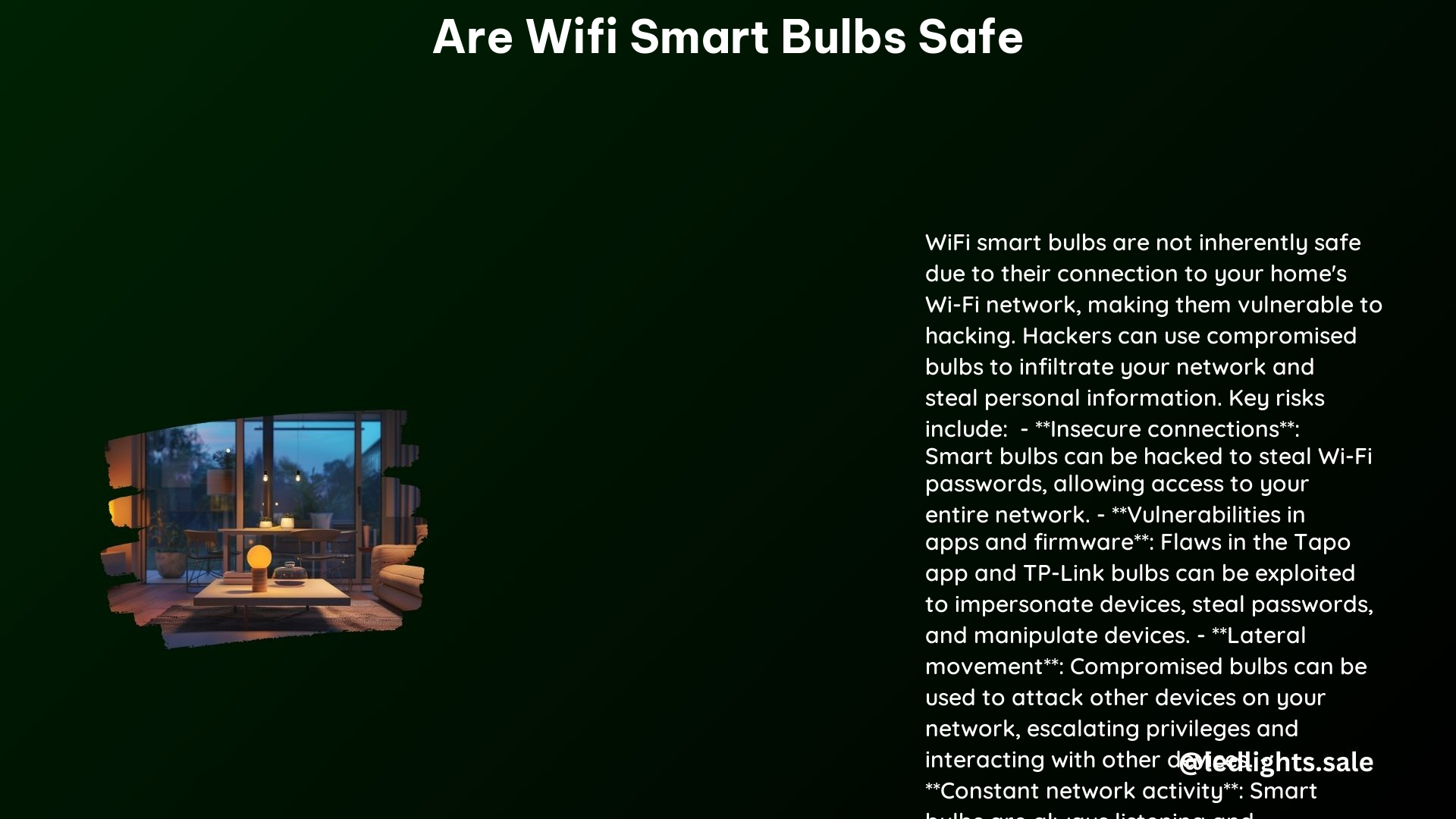As the adoption of smart home technology continues to grow, WiFi-enabled smart bulbs have become increasingly popular for their convenience and energy-efficiency. However, these connected devices can also pose significant security risks if not properly secured. In this comprehensive guide, we’ll explore the potential vulnerabilities of WiFi smart bulbs and provide you with a detailed playbook to ensure the safety and security of your smart home environment.
Risks and Vulnerabilities of WiFi Smart Bulbs
Hacking and Data Theft
Smart bulbs can be a gateway for hackers to gain access to your home network and sensitive information. Vulnerabilities in the bulbs’ firmware and associated mobile apps can allow cybercriminals to retrieve passwords, personal data, and even control the devices remotely. According to a study by Kaspersky, over 1.5 million smart home devices were targeted by malware in 2019 alone, with smart bulbs being one of the most vulnerable components.
Lateral Movement
Once a smart bulb is compromised, hackers can use it as a pivot point to attack other devices on the same network, escalating their privileges and gaining access to a wider range of connected systems. This “lateral movement” technique is a common tactic used by advanced persistent threat (APT) groups, who can then leverage the compromised devices to steal sensitive information or launch further attacks.
Insecure Authentication
Many smart bulbs and their associated apps rely on weak or default authentication mechanisms, making it easier for hackers to impersonate devices and gain unauthorized access. A study by the University of Michigan found that over 50% of smart home devices use easily guessable passwords, further exacerbating the risk of unauthorized access.
Privacy Concerns
Smart bulbs can also pose privacy risks, as they may collect and transmit data about your usage patterns, location, and other personal information. This data can be vulnerable to interception or misuse by third parties, potentially exposing you to identity theft or other privacy-related threats.
Securing Your WiFi Smart Bulbs

To mitigate the risks associated with WiFi smart bulbs, it’s essential to implement a comprehensive security strategy. Here are some key steps you can take:
1. Choose Secure Bulbs from Reputable Manufacturers
When selecting smart bulbs, prioritize products from manufacturers with a proven track record of security and privacy practices. Look for bulbs that have undergone rigorous security testing and offer regular firmware updates to address vulnerabilities. Some of the most secure smart bulb options include Philips Hue, LIFX, and Nanoleaf.
2. Implement Strong Authentication
Ensure that your smart bulb accounts and associated mobile apps use strong, unique passwords that are at least 12 characters long and include a mix of uppercase and lowercase letters, numbers, and special characters. Additionally, enable two-factor authentication (2FA) whenever possible to add an extra layer of security.
3. Isolate Smart Bulbs on a Separate Network
Consider segmenting your home network and placing your smart bulbs on a separate virtual local area network (VLAN) or guest network. This network isolation can help prevent lateral movement and limit the potential impact of a compromised smart bulb on the rest of your connected devices.
4. Keep Firmware and Software Up-to-Date
Regularly check for and install the latest firmware and software updates for your smart bulbs and their associated mobile apps. These updates often include security patches that address newly discovered vulnerabilities, helping to keep your devices secure.
5. Use a Smart Home Hub
Connecting your smart bulbs to a dedicated smart home hub, such as Amazon Echo, Google Home, or Samsung SmartThings, can provide an additional layer of security. Hubs often offer more robust authentication mechanisms and can help isolate your smart bulbs from direct internet access.
6. Monitor for Security Alerts and Vulnerabilities
Stay informed about the latest security threats and vulnerabilities affecting smart home devices, including your WiFi smart bulbs. Subscribe to security newsletters, follow industry news, and regularly check the manufacturer’s website for any security advisories or updates.
7. Implement Secure Configuration Settings
Carefully review and configure the security settings of your smart bulbs, ensuring that you disable any unnecessary features, use secure communication protocols (e.g., WPA2-AES), and avoid using default or easily guessable passwords.
By following these best practices, you can significantly enhance the security and privacy of your WiFi smart bulbs, reducing the risk of hacking, data theft, and other cyber threats.
Conclusion
As the smart home ecosystem continues to evolve, the security of WiFi-enabled devices, such as smart bulbs, has become a critical concern. By understanding the potential risks and vulnerabilities, and implementing the appropriate security measures, you can enjoy the convenience of smart home technology while safeguarding your personal information and the integrity of your connected devices.
Remember, the key to securing your WiFi smart bulbs lies in a proactive and multilayered approach, combining the right hardware, software, and network configurations. Stay vigilant, keep your devices updated, and prioritize security to ensure a safer and more secure smart home environment.
References:
- Kaspersky. (2019). Smart Home Devices Under the Spotlight: Kaspersky Security Bulletin 2019. https://securelist.com/smart-home-devices-under-the-spotlight/95148/
- University of Michigan. (2018). Security Analysis of Emerging Smart Home Applications. https://www.usenix.org/conference/usenixsecurity18/presentation/feng
